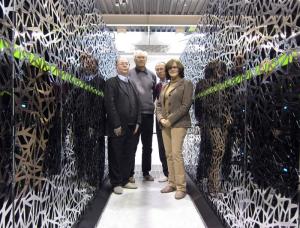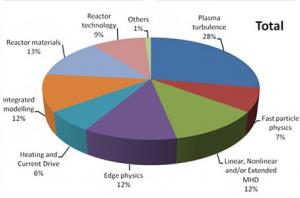Helios supercomputer ready to bite the bytes
3 Feb 2012
-
Aris Apollonatos, Fusion for Energy
The CEA-F4E CSC team standing between a section of the Helios supercomputer, from left to right: Jacques David, François Robin, Jacques Noé (CEA) and Susana Clement Lorenzo (F4E).
The Helios supercomputer is operational according to schedule at the International Fusion Energy Research Centre (IFERC) hosted by the Japanese Atomic Energy Authority (JAEA) in Rokkasho. The machine, whose mission it is to perform complex calculations for plasma physics and fusion technology, has passed its acceptance tests achieving 1,132 Petaflop LINPACK [1] performance.
The Computer Simulation Centre (CSC), where Helios operates, is an important component of Europe's contribution to the Broader Approach, an agreement signed between Europe and Japan to complement the ITER project through various R&D activities in the field of nuclear fusion. The European participation to the Broader Approach is coordinated by Fusion for Energy. The supercomputer was provided by France as a part of its voluntary contribution to the Broader Approach, through a contract between the Commissariat à l'Energie Atomique et aux Energies Alternatives (CEA) and manufacturer Bull.
The acceptance tests of the supercomputer were carried out between 13-22 December 2011 in Rokkasho, Japan. The tight construction schedule was successfully met offsetting any disruptions caused by the great East-Japan earthquake in March 2011. The installation of the equipment was completed in early December and by the end of the month a 1,132 Petaflops LINPACK performance was achieved, ranking Helios fifth in the TOP-500 November 2011 list.
The operation of the supercomputer will kick off with four high visibility runs ("light-house projects") which are expected to shed light on plasma calculations. From January to March 2012, the four selected codes will run one at a time to test drive the capacities of the supercomputer and achieve maximum performance. The first call for proposals has attracted high numbers of submissions from both European and Japanese researchers that are currently under review. It is expected that routine operation will start in April 2012.
Based on the number of proposals submitted to the first call, there has been an oversubscription by a factor of three of the computer's time, demonstrating the great interest from the European and Japanese fusion communities in the supercomputer facility. The majority of proposals address issues related to plasma physics (turbulence, MHD, edge physics and integrated modelling) together with an important number of proposals addressing technology issues.
[1] The LINPACK benchmark is a measure of a computer's floating point rate of execution. It is the performance parameter used to classify the TOP 500 list of supercomputers.



